


所属成套资源:外研版(一年级起点)小学四年级英语上册课件PPT+教案
- 外研版(一年级起点)小学四年级英语上册 Module 9 Unit 2 I bumped my head. 课件 课件 0 次下载
- 外研版(一年级起点)小学四年级英语上册 Module 9 Unit 1 What happened to your head? 课件1 课件 0 次下载
- 外研版(一年级起点)小学四年级英语上册Module 10 Unit 2 Eat vegetables every day. 课件 课件 0 次下载
- 外研版(一年级起点)小学四年级英语上册Module 10 Unit 2 Eat vegetables every day. 教案1 教案 0 次下载
- 外研版(一年级起点)小学四年级英语上册 Module 10 Unit 1 Go to bed early. 课件3 课件 0 次下载
外研版 (一年级起点)四年级上册Unit 1 What happened to your head?教案及反思
展开
这是一份外研版 (一年级起点)四年级上册Unit 1 What happened to your head?教案及反思,共7页。教案主要包含了教材分析,学情分析,教学目标,教学重点和难点,教学准备,教学过程,板书设计等内容,欢迎下载使用。
Module 9 Unit 1 What happened to your head? 教学设计 一、教材分析 本课选自外研社版新标准英语(一年级起点)四年级上册,课文情境是Amy 和Lingling询问Daming的头发生了什么事情,并由Daming回忆和Sam在一起的事件经过。教材的编写符合孩子们的心理特点,情节有趣并来源于生活,语言的实践性较强,学生感兴趣。本课主要内容是学习会用“What happened to……?”来询问别人发生了什么事情,并能根据一定的场景来回答摔倒、碰撞、摔下来。学习单词happen, thirsty, watermelon, carried, bumped,以及短语 bike ride, fell off, took …to。二、学情分析 在本教材教学内容之前,学生已经学习了单词的过去式及相应的特殊疑问句型。如:I helped my mum./Did you see it?/ Where did you go yesterday?本课继续学习一般过去时,有所不同的是本课涉及到了动词过去式的规则及不规则变化,如:happened, carried, fell off, took。难点在于掌握carry, fall off, fall over, bump变成过去式的特殊变化,并能熟练运用这些词描述自己过去的经历。 为此,课堂需遵循以学生为中心,以兴趣为支点,以交流为目的,以现实生活为情境的原则,运用情境教学法,小组合作法,利用课件、视频、图片,创建活动让学生积极参与。在学习巩固新授句型的基础上,为学生搭建框架,教给学生如何去描述自己过去发生了什么,最终完成学习任务。三、教学目标1.语言知识目标:(1)通过课件,图片,视频等材料,使学生在语境中正确感知,并听、说、认、读单词:happened, bike ride, watermelon, thirsty, carried, fall off- fell off, bumped;(2)使学生能在合适的语境下正确运用句子:①I went for a bike ride. ②He/ She/ I bumped head. ③ He/ She/ I fell off bike.(3)使学生能正确理解课文大意,流利的朗读课文,尝试复述课文。 2.语言技能目标: 通过对图片情境的理解,能描述意外事件的经历。3.情感态度与价值观: 通过对意外事故的描述,培养学生日常生活中注意安全、保护自己的意识。 四、教学重点和难点1. 教学重点(1)掌握如下单词的意义及用法:happened, bike ride, watermelon, thirsty, carried, fall off- fell off, bumped.(2)正确运用句子:①I went for a bike ride.②He/ She/ I bumped head. ③ He/ She/ I fell off bike.(3)正确理解课文大意,流利的朗读课文并配音。2.教学难点:复述课文内容,并运用所学语言描述意外事件(故事)。 五、教学准备 多媒体课件、单词卡片 、粘贴教具、小组合作单六、教学过程 Step1 Warming –up GreetingsT: What do you usually do at the weekend?S: I usually … 【设计意图: Greetings环节,帮助师生相互了解,通过师生对话了解学生的英语知识背景和基本能力水准,明确教学依据,同时为下面的环节做好铺垫。】Step2 Presentation1. Lead in T:I usually go for a bike ride at the weekend. (根据图片引入 go for a bike ride)Yesterday, Daming and Sam also… (此处停顿,显示go for a bike ride) T: No, they went for a bike ride.【设计意图:接着上一话题,直接引入到Daming和Sam昨天的活动,导入本课的事件起因,自然过渡到课文。通过停顿及强调让学生感受go for a bike ride的过去式,即went for a bike ride,体会时态的不同。】
【设计意图: Greetings环节,帮助师生相互了解,通过师生对话了解学生的英语知识背景和基本能力水准,明确教学依据,同时为下面的环节做好铺垫。】Step2 Presentation1. Lead in T:I usually go for a bike ride at the weekend. (根据图片引入 go for a bike ride)Yesterday, Daming and Sam also… (此处停顿,显示go for a bike ride) T: No, they went for a bike ride.【设计意图:接着上一话题,直接引入到Daming和Sam昨天的活动,导入本课的事件起因,自然过渡到课文。通过停顿及强调让学生感受go for a bike ride的过去式,即went for a bike ride,体会时态的不同。】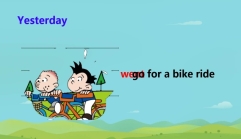 2. New words learning(1) 展示Daming和Sam骑车口渴的图片,提出问题 ,教授thirsty.
2. New words learning(1) 展示Daming和Sam骑车口渴的图片,提出问题 ,教授thirsty. (2) Did they buy some water?(出示Yes/ No请学生猜测)教授buy- bought, watermelon和bought a watermelon.【设计意图:让学生通过猜测了解故事的发展,激发学生的好奇心,鼓励学生积极大胆的质疑和猜测。同时对watermelon和bought a watermelon进行教授。】
(2) Did they buy some water?(出示Yes/ No请学生猜测)教授buy- bought, watermelon和bought a watermelon.【设计意图:让学生通过猜测了解故事的发展,激发学生的好奇心,鼓励学生积极大胆的质疑和猜测。同时对watermelon和bought a watermelon进行教授。】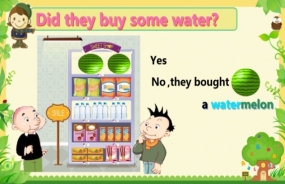 3. Listen and answer questions(1)T: They bought a watermelon, but finally Daming and Sam went to the hospital, so what happened? Let’s see!
3. Listen and answer questions(1)T: They bought a watermelon, but finally Daming and Sam went to the hospital, so what happened? Let’s see! 【设计意图:此处直接告诉学生故事的结果,Daming和Sam买完西瓜后却进了医院,设置悬念,引出疑问:What happened?注重学生思维品质的培养。】(2) Listen and answer the questionsa. Who carried the watermelon on the bike?(教授carry-carried)Daming B. Sam
【设计意图:此处直接告诉学生故事的结果,Daming和Sam买完西瓜后却进了医院,设置悬念,引出疑问:What happened?注重学生思维品质的培养。】(2) Listen and answer the questionsa. Who carried the watermelon on the bike?(教授carry-carried)Daming B. Sam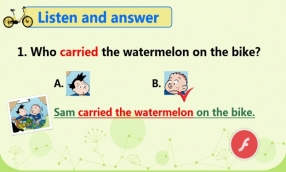 b. Did Daming fall off his bike?(教授fall off-fell off)A. Yes B. No
b. Did Daming fall off his bike?(教授fall off-fell off)A. Yes B. No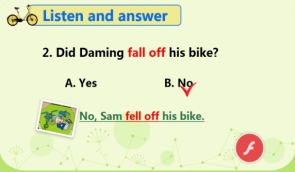 c. Who bumped his head?(教授bump-bumped)A. Damimg B. Sam
c. Who bumped his head?(教授bump-bumped)A. Damimg B. Sam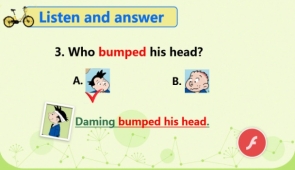 4. Listen and repeat(1)Listen to the text and repeat it together.(2)Read the text by yourself.5. Dubbing show【设计意图:巩固上一个环节的听音跟读,给学生时间分角色练习朗读,激发学生有效合作,用配音的方式挖掘学生的配音能力和表演潜能,教师给予语音、语调、语气的指导,体现课堂独特魅力。】6. Choose and matchChoose the correct picture and match the sentence.
4. Listen and repeat(1)Listen to the text and repeat it together.(2)Read the text by yourself.5. Dubbing show【设计意图:巩固上一个环节的听音跟读,给学生时间分角色练习朗读,激发学生有效合作,用配音的方式挖掘学生的配音能力和表演潜能,教师给予语音、语调、语气的指导,体现课堂独特魅力。】6. Choose and matchChoose the correct picture and match the sentence.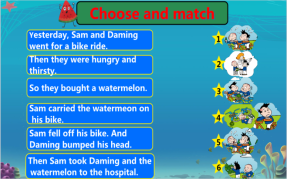 Step3 Retell the storyThe teacher helps students retell the story.【设计意图:对知识进行拓展和延伸,激发学生灵活运用语言的潜能。】Step4 Group workFour students in a group.Fill in the blanks.Talk about what happened to the boy, and then tell stories.
Step3 Retell the storyThe teacher helps students retell the story.【设计意图:对知识进行拓展和延伸,激发学生灵活运用语言的潜能。】Step4 Group workFour students in a group.Fill in the blanks.Talk about what happened to the boy, and then tell stories.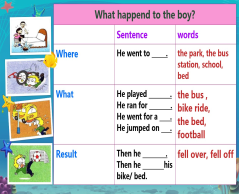
 【设计意图:以小组合作的形式在新的语境中运用所学单词和知识框架(when, where, what, result)创编故事,提升学生的知识迁移能力。合作填空,激发学生主动合作的热情,深度学习、内化知识。】Step5 Emotional teachingListen to a song and summarize: be careful in our daily life.Step6 HomeworkRetell the story by yourself.Describe what happened to you last weekend.七、板书设计:
【设计意图:以小组合作的形式在新的语境中运用所学单词和知识框架(when, where, what, result)创编故事,提升学生的知识迁移能力。合作填空,激发学生主动合作的热情,深度学习、内化知识。】Step5 Emotional teachingListen to a song and summarize: be careful in our daily life.Step6 HomeworkRetell the story by yourself.Describe what happened to you last weekend.七、板书设计: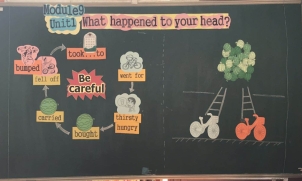
相关教案
这是一份外研版 (一年级起点)四年级上册Unit 1 What happened to your head?优秀教案及反思,共3页。教案主要包含了Warmer,Practice, Task cmpletin等内容,欢迎下载使用。
这是一份小学英语Unit 1 What did you put in your bag ?教案,共2页。
这是一份小学外研版 (一年级起点)Unit 1 What happened to your head?教案设计,共5页。









